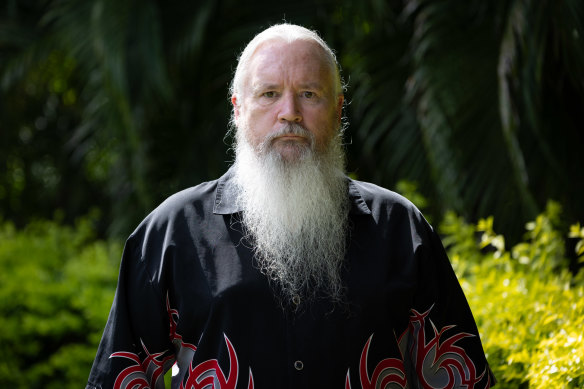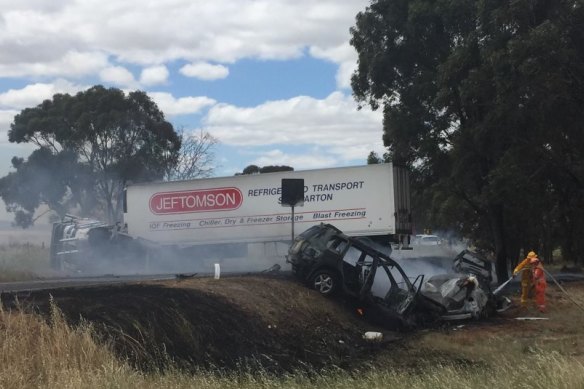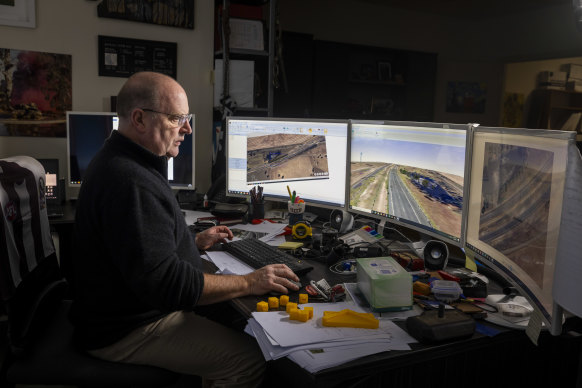This was published 10 months ago
Geoffrey’s killer cough put him in jail. A phone call to his brother got him out
The truck driver is not sure if convicted murderer Robert Farquharson is innocent – but he can see similarities with his own unjust imprisonment.

Geoffrey Ferguson’s life was changed forever when he was wrongly convicted and jailed for culpable driving after coughing and passing out in his truck.Credit: Paul Harris
Geoffrey Ferguson doesn’t know Robert Farquharson.
They never met in the Victorian prison system. Nor does Ferguson, a former truck driver, have a firm view of the guilt or innocence of Farquharson, the man convicted for triple murder after driving his three sons into a dam on Father’s Day in 2005.
He does, however, identify with key aspects of Farquharson’s case that many people can’t get over – his claim to have had a coughing fit and his strange, self-centred behaviour immediately after his three sons, Jai, 10, Tyler, 7, and Bailey, 2, had died.
In October 2015, Ferguson himself had an episode of cough syncope – a rare condition that’s well known in the medical literature – which caused him to pass out while driving his truck in northern Victoria.
As he was unconscious, his semi-trailer veered to the wrong side of the road and killed a man in an oncoming car. It’s the same condition that Robert Farquharson said caused him to run off the road into the dam.

The crash scene where a man died after Ferguson, the truck driver, coughed, passed out and ran into an oncoming car in a case of cough syncope.
In both cases, juries rejected their stories and found them guilty. Ferguson was sentenced to seven years and nine months in jail for culpable driving causing death and a range of lesser charges.
In episode two of investigative podcast, Trial By Water, released to this masthead’s subscribers today, Ferguson tells his full story.
Listen to episode two here, right now.
He relates how his brother witnessed his coughing fit during a phone call on a bluetooth headset, and how he woke up in time to see an oncoming vehicle but too late to avoid it. He tells how police disbelieved the coughing story from the beginning and how his stint in prison changed his life forever.
In both the truck driver’s case, and that of Farquharson 10 years earlier, police and prosecutors discounted the cough syncope story and used their apparently odd and cold behaviour in the immediate aftermath of the crash to suggest in court that they were guilty.
Neither man dialled triple zero. Ferguson instead called a lawyer after being advised by a truck driving friend that when “someone dies, someone’s going to jail”. This was held against him in court.
“I had already accepted that he was dead and my mind analytically moved on to ‘what happens next’.”
Geoffrey Ferguson on his behaviour at the scene of the fatal crash
In Farquharson’s case, in an interview at the Geelong hospital hours after the crash, police became suspicious when he shed no tears for the deaths of his children, but did inquire “what’s the scenario for me?” and “what’s going to happen to me?” A day after he had asked those questions of senior sergeant Jeffery Smith, Farquharson’s case was in the hands of the homicide squad.
His behaviour also counted against him in the public mind, where people could not understand the way he stood by at the side of the dam on the night of the crash and smoked cigarettes while others dived in to search for his children.
Ferguson told this masthead that, having lived through a similar incident, he could understand Farquharson’s demeanour.
“Although most people wouldn’t understand it because they haven’t been in that situation, I concur that Robert’s calm demeanour at the scene and asking the police about what would happen to him were not necessarily signs of guilt,” Ferguson says.
“In my case I can say that at the time, I felt more than a little detached from the situation … it felt totally surreal.
“Even though I didn’t feel guilty and somehow knew that I hadn’t done anything wrong, I also couldn’t explain what had happened either. I remember wondering in a clinical kind of way, what would happen to me moving forward.”
This was not that he was insensitive to the fact that the other man was dead.
“But because I had already accepted that he was dead and my mind analytically moved on to ‘what happens next’. It’s hard to explain it properly to anyone who hasn’t been in a similar situation … Maybe it’s a survival mechanism. I don’t know.”
It also struck the truck driver that Farquharson had not asked for a lawyer or declined to talk to the police.
“A guy who’s never been in trouble before probably wouldn’t be aware that he should’ve done both,” Ferguson said. Ferguson’s lawyer recommended he co-operate with police so he did his first interview without a lawyer present – something he described as “the worst advice I ever got”.
Records from Farquharson’s court cases suggest that, in the days after the crash that killed his children, he was offered the opportunity to speak to a lawyer, but declined to do so, saying he had nothing to hide.
There are other similarities between the two cases.
The prosecution expert who downplayed the likelihood that each man could have suffered cough syncope was the same – Monash University adjunct professor Matthew Naughton. A storied respiratory physician, who openly admitted he had little experience with or knowledge of cough syncope, gave evidence that apparently helped convince the juries in both cases that it was a vanishingly rare condition that was unlikely to have explained either crash.
The Age and The Sydney Morning Herald are not suggesting Naughton in any way acted inappropriately. He was honest with the court about his areas of expertise and experience.
The global expert in cough syncope, Dr Peter Dicpinigaitis, a professor of medicine at New York’s Albert Einstein College of Medicine, told the podcast that the archetype of the person who suffers from cough syncope over the past 150 years fitted Farquharson’s description: “a short and stocky man with lung disease”.
“And your first episode can happen ... while you’re driving a car, it can happen while you’re waiting for the train sitting next to the tracks. Or hopefully you’d have it at home where there’s a sofa nearby,” Dicpinigaitis said.
Police traffic reconstruction experts also argued in both the Ferguson and Farquharson cases that their vehicles had been directed by “steering inputs” which proved the driver had been conscious.
Ferguson said in his case police had not taken account of a stiff cross-wind that had been pushing his truck to the right all day.
In Farquharson’s case the police had argued three distinct steering inputs to get his old Commodore from the road to the dam proved he was conscious at the time. But as revealed in Trial By Water, engineer Dr Shane Richardson, who has been doing forensic crash investigations for more than 20 years, surveyed the scene of Farquharson’s crash and scrutinised the police evidence and found it wanting.
“There’s no way to prove beyond a reasonable doubt that there were three distinct driver steering inputs to change the direction of the car, when there are other factors that could explain that.” Among the factors were a slope and a fence which both would have conspired to pull the car towards the dam, even if Farquharson was unconscious as he claimed.

Forensic crash engineer Dr Shane Richardson has reconstructed the scene of Robert Farquharson’s crash and says there’s serious doubt about the police evidence.Credit: Wayne Taylor
In the court case, the police evidence changed over time, but the argument there were three steering inputs remained.
Unlike Farquharson – who is serving 33 years in prison for triple murder – the truck driver, Ferguson, was released from prison after two years when an appeal court said the jury had got the verdict wrong. They should not have ignored the witness evidence of his brother who heard Ferguson on the phone cough and pass out, the court said.
Ferguson’s conviction was quashed and he was immediately set free.
The judges of the appeal court also pointed out that Naughton – a respiratory physician who has specialised in sleep apnoea – had conceded in cross-examination that Ferguson might have been unconscious, though he argued it was more likely he was asleep.
And the judges rebuked the prosecutor in Ferguson’s case, who had told the jury: “Don’t be duped for a minute by this cough syncope”, and also: “Are you going to fall for that?”
They said the prosecutor’s language was “a contravention of his responsibility to the court and to the system of justice”.
Ferguson might be free, but his imprisonment has changed him forever. He suffers from post-traumatic stress, can’t work and can barely leave the house or drive.
And he missed one of the most important days of his life.
“While I was in prison, I got a phone call from my brother to say that my father had passed away,” he said. “We were friends, as well as being father and son. He was my best man at my wedding. So that’s how close we were.”
Even if he could have got out of prison to come to the funeral, Ferguson did not want to disgrace him by showing up in handcuffs.
“He passed away thinking I was a convicted criminal.”